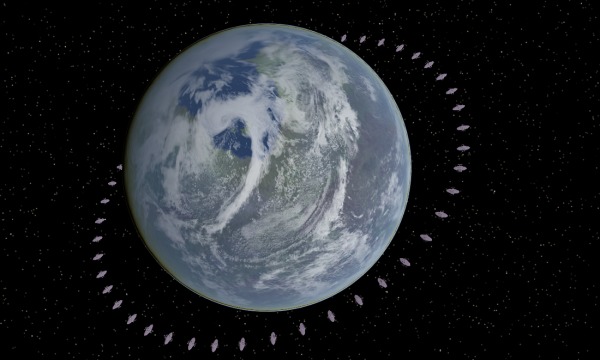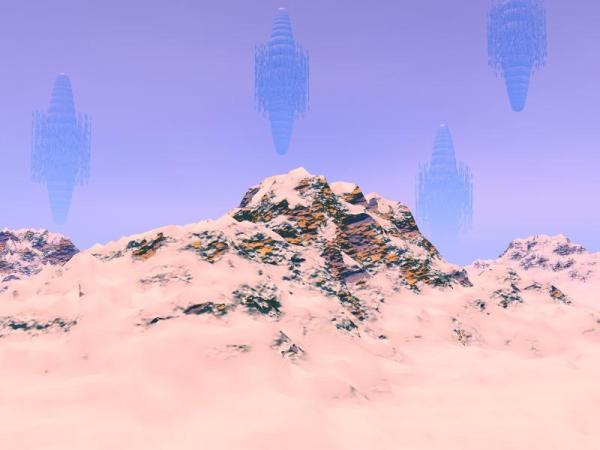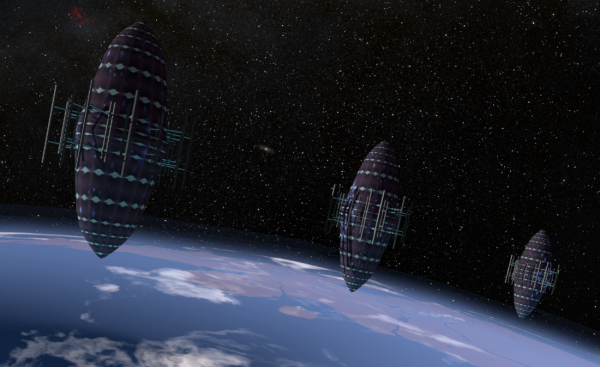BY LETTER
April
Galactography > Regions of Space > Inner Sphere
Galactography > Systems and Worlds > Systems & Worlds A - B
Galactography > Systems and Worlds > Systems & Worlds A - B
Highly tilted world with a unique geneered biosphere | |
 Image from Steve Bowers | |
| April during an equatorial season, when nearly the entirety of the surface enjoys moderate illumination. Soon, however, one hemisphere will plunge into the long night of the winter and the other will be showered by constant sunlight, creating extreme climates that sweep across nearly the entire globe. To prevent the planet from freezing over, April's atmosphere is slightly thicker and contains high levels of carbon dioxide. This planet is surrounded by a ring of macrostats, long orbiting habitats which are large enough to produce a small amount of tidally-induced gravity effects at each end. Most of the population lives in these habitats. | |
Beta Hydri - Data Panel | |
| Star | Names: Beta Hydri, Calendar |
|---|---|
| Physical characteristics | - Mass: 2.148E+30 kg (1.08 x Sol) - Radius: 1,258,521 km (1.809 x Sol) - Luminosity: 3.505 x Sol (bolometric) - Temperature: 5,872 Kelvin - Spectral type: G2IV - a G-type subgiant star whose brightness has, as of 10600 AT, increased to over three times its main sequence luminosity. - Age: 6.40 billion years - Distance from Sol: 25.297 ly (10600 AT) - Galactic xyz 10.61,-15.34,-15.69 |
The Planets of Beta Hydri - Data Panel | |
| Planets | Surviving records found at the Aristotle (Delta Pavonis) system suggested that the names of the planets in this system were chosen by a public vote organized by Earth's astronomical organization in 376 as an homage to the old Gregorian calendar, which was being replaced by the Tranquility calendar across much of the Solsys. Undecember was named later, during the First Federation era, by the colonists. - 2 Jovians: September and October. - 3 Neptunians: August, November, and December. - 4 Superterrestrials: January, February, March, June. - 3 Terrestrials: April, May, and July. - 15 dwarf planets, including Undecember |
|---|---|
April - Data Panel | |
| Orbital characteristics | - Semi-major axis: 287,378,000 km (1.921 AU) - Period: 935.8 days (2.562 Julian years) - Eccentricity: 0.043 |
|---|---|
| Physical characteristics | - Type: Skolian (a highly tilted terrestrial world, transformed by ecopoesis to support a specialised biosphere - Mass: 1.445E+24 kg - Radius: 4,201.7 km - Density: 4,651 kg/m^3 - Gravity: 5.463 m/s^2 (0.557 g) - Rotation period: 121,406 s (33.72 hr) - Obliquity: 62.9° - Albedo: 0.331 (highly variable) - Average surface temperature: 296 K (highly variable) |
| Atmosphere | - Surface pressure: 122 kPa - Composition: 80% N2, 20% O2, 0.1% CO2, traces of other gases. |
| Satellites | none |
The plans for planetary engineering drawn up for this planet did not entail reproducing an Earth-like environment. Rather, the clients more interested in creating a novel biosphere that could thrive on this highly tilted planet. It is for this reason that Nagaya Moyale specified that the resulting state must not utilize any weather machines. This requirement, combined with the harsh seasons, the direct result of the planet's Skolian-level axial tilt caused by both its massive neighbors and the lack of stabilizing effects of large natural satellites, forced Mumlan Terrainvestment to initiate its most ambitious endeavor ever: the ecopoesis of a non-standard biosphere to thrive in the highly variable temperatures, wind speeds, and day lengths found on this world.
The risky gambit proved fruitful, and the ecopoesis project concluded in 2538 AT. The remarkable speed of the terraformation project was made possible by the megacorp's cooperation with several existing entities in the system, such as the Association of Rainy Habitats and the Goodwork League, the former of which helped to hydrate the planet up roughly a hundred years before the arrival of the Mumlan probe in 1615, and the latter agreeing to trade their infrastructure construction services for habitat ecosystem designs for its own uses.
By this time, the colonists (who were a combination of the inhabitants of the Nagaya Moyale, former employees from Mumlan Terrainvestment, and other groups), who had arrived at the system long before the completion of the ecopoesis project, had already adopted the modifications required to live comfortably in the planet's highly variable surface environment. In particular the raised levels of carbon dioxide in the atmosphere required specialised tweaking.
However, only around one-fourth of the colonists ultimately moved down to the surface. A larger fraction of the colonists opted to remain in space, preferring to watch their world from afar. They constructed an orbital band in a relatively low orbit (this band would later be incorporated into the planet's signature macrostat band in the 8200s) using infrastructure left behind from the ecopesis phase. It would later serve as the gateway to the planetary surface for tourists.
April became well known for its seasonally variable scenery, and strange life forms with uniquely adaptable behavior. These are the results of both practical and artistic innovations made by Mumlan Terrainvestment during the biosphere design phase. Thanks to the curious nature of these developments, April quickly found a niche as a unique ecological tourist spot in its home system. Its fame reached other stars and it became some of the more popular destinations in the Inner Sphere (a rival to Darwin with its natural biosphere) during the late 3rd millennium.
The highly adaptable and variable tweak sleeve design adopted by surface dwelling sophonts became part of the planet's signature culture for millennia to come. This design has influenced the development of similar sleeves on many other worlds with extreme variations of climate and weather conditions.
 Image from Anders Sandberg | |
| Macrostats above Mt Hara on April, Beta Hydri II | |
Only Connect! to Aksijaha.
 Image from Steve Bowers | |
| Macrostats above April. The centre of gravity of each habitat is in orbit at 2000 km above the surface, and the structure is extended two hundred kilometres in both directions (inward and outward). At the extremities of each habitat, tidal effects produce a low level of acceleration, approximately 0.02 gees in each case. This is similar to the gravity levels on a small moon or planetoid. | |
Appears in Topics
Development Notes
Text by Anders Sandberg
Updated by The Astronomer and Steve Bowers in 2020
Initially published on 08 October 2001.
Updated by The Astronomer and Steve Bowers in 2020
Initially published on 08 October 2001.






